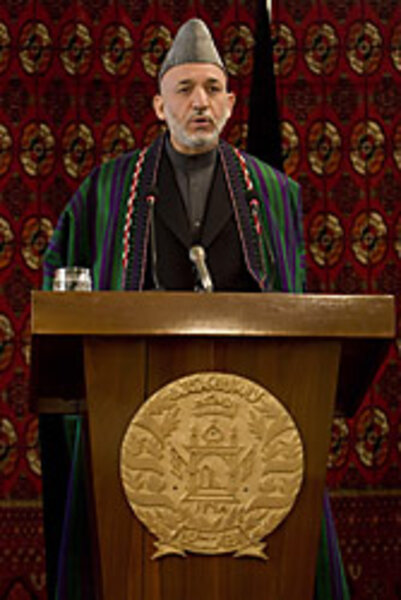Afghanistan's insurgency spreading north
Loading...
| Kabul, Afghanistan
The attempted assassination of President Hamid Karzai Sunday came as the latest sign of a trend worrying Western officials: that the insurgency is spreading from the Taliban stronghold of the south to the central and northern regions of the country.
The militant attack, the biggest in Kabul since mid-March, came during a public ceremony. Despite a massive security presence, militants managed to fire bullets and rockets at the president, killing two nearby lawmakers and a boy.
The insurgency in Afghanistan has not been "contained," Director of National Intelligence Michael McConnell testified before a Senate subcommittee in February. "It's been sustained in the south, it's grown a bit in the east, and what we've seen are elements of it spread to the west and the north."
A recent study by Sami Kovanen, an analyst with the security firm Vigilant Strategic Services of Afghanistan, echoed this assessment. He reported 465 insurgent attacks in areas outside the restive southern regions during the first three months of 2008, a 35 percent increase compared with the same period last year. In the central region around Kabul there have been 80 insurgent attacks from January through March of this year, a 70 percent jump compared to the first three months of last year.
The numbers are part of a nationwide trend of rising violence. In the southern and southeastern provinces, including the insurgent hotbeds of Kandahar and Helmand, guerrilla attacks spiked by 40 percent, according to Mr. Kovanen's research.
Kabul itself has been largely free from the violence, but as Sunday's attack shows, there are signs that the Taliban's presence is growing here, too. On the sprawling, serene campus of Kabul University, where the nation sends many of its best and brightest, the Taliban has reached an unprecedented level of influence, students say.
Young men gather in campus dorm rooms and watch slickly produced DVDs of the latest insurgent attacks. One video shows Taliban fighters firing rocket launchers and shrieking, "God is the greatest!" as orange fireballs reach their targets, presumably Coalition forces, in the distance. The attacks are set to religious music, backed by a staccato drumbeat meant to impassion and inspire viewers.
"Many of us have contact with Taliban leadership," says one student and Taliban member, who asked to be called Naqibullah. "I talk to commanders based in the south maybe once a week on the phone." Naqibullah and others like him disseminate Taliban propaganda throughout the university, hoping especially to reach students from various parts of the country.
Naqibullah suggests that places like Kabul University might be a fertile recruiting ground for operations in the capital and in northern areas of the country. "There are many students waiting to launch suicide attacks," he says. "One student launched a suicide attack in Bagram," an American base north of the capital.
"I, too, would like to become a suicide bomber," Naqibullah continues. "But educated Taliban like me are needed to teach the uneducated ones." Instead, the young man is training to become a doctor so he can eventually treat the war wounds of Taliban fighters.
Insurgents' influence is spreading to the northern and western regions of the country as well, analysts say. In the northern province of Baghlan, insurgent group Hizb-i-Islami is growing in presence, says Antonio Giustozzi, a researcher at the London School of Economics and an expert on the Afghan insurgency. Hizb-i-Islami, once the country's leading mujahideen party, was a US and Pakistani ally when the Soviet Union invaded Afghanistan. Today it is considered one of the most effective insurgent groups in the north and east, and it is aligned with the Taliban and Al Qaeda.
The group has received a surge of funding in the last year, says Mr. Giustozzi, allowing it to spread from its eastern stronghold near the Pakistani border – where it has launched many attacks against Coalition forces – into northern areas. "They are regrouping and reactivating old networks that existed during the Russian war and the '90s," he says.
Taliban insurgents are making headway in some districts in the far western province of Badghis, according to Satar Barez, deputy governor of the neighboring Faryab Province. "There are now frequent bombings and kidnappings in Badghis," Mr. Barez says. In the first quarter of 2007 there was just one insurgent attack in Badghis, but the guerrillas have already launched 17 in the first three months of this year.
While violence in the north has not reached the levels seen in the restive south, Giustozzi says that in many areas insurgents are in the initial stages of infiltration and propaganda, just as they were in the south after the 2001 invasion.
"We have openly engaged the government and foreign forces in the south, but in the north we are quietly expanding our area," a Taliban commander told reporters past year.
In some northern provinces, the Taliban issue "night letters," documents posted to villagers' doors at night threatening them if they spport the government or Coalition forces, locals report. The tactic has been highly successful in intimidating residents in the south and quelling support for the international presence.
But analysts say the insurgency is spread not by fear alone: A weak central government and the country's declining socioeconomic situation also bolster militants' efforts. "The population of Afghanistan is becoming disillusioned with the government," Halim Kousary, an analyst with Centre for Conflict and Peace Studies, a Kabul-based think tank. "People in the north believe there hasn't been enough reconstruction."
Analysts suggest that the north is taking on increased importance to the Taliban because of the major drug smuggling routes that cut through it.





